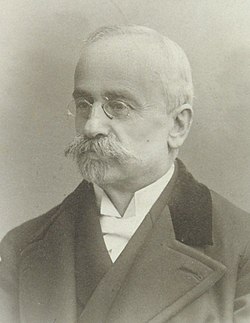Biography:Emilio Villari
Emilio Villari (25 September 1836 – 20 August 1904) was an Italian experimental physicist and a professor at the University of Bologna and later Naples who contributed to studies on electromagnetism after whom is named the Villari Effect which is used in devices used to measure mechanical stress and strain. He also developed a quadrant electrometer.
Early life
Villari came from a wealthy family, his father was a lawyer and a younger sibling was Pasquale Villari. Suffering from epileptic seizures from an early age he was privately educated in Naples including in literature under Leopoldo Rodino, math under Achille Sannia and physics from Luigi Palmieri. He then went to the University of Pisa where his brother Pasquale taught. He studied medicine initially but was influenced by Riccardo Felici to shift to physics.[1]
Career
Villari spent some time in Germany in the laboratory of Gustav Magnus before joining the University of Bologna in 1871 as professor of physics. In 1900 he moved to Naples to succeed Gilberto Govi. In 1873 he examined why alternating current causes greater heat generation in metals than direct current. Villari suggested that this was due to the existence of molecular magnets and their resistance to induced electromagnetism and differed in his theory from that of Maxwell and Kelvin. He examined the expansion of ferromagnetic materials under electromagnetism and discovered the reverse effect as well which is sometimes known as the Villari Effect. The Villari effect is put into application in strain sensors in a wide range of engineering situations. In 1901 he published on the effect of X-rays on the ionizability of air.[2][3] He constructed electroscopes and observed the effect of (radiation from) pitchblende on discharges.[4] Other experiments were on electrical capacitance, the elasticity of rubber, and the flow of liquids like mercury through tubes.[5] Most of his experimental work was published in the journal Il Nuovo Cimento (1877-1894). Adolfo Bartoli worked on radiation thermodynamics with Villari in Bologna for some time. Augusto Righi worked as an assistant to Villari while Mario Pieri was a student.[6] He was a foreign member of the Royal Society.[7] Villari received the Matteucci Medal for 1884.[8][9]
References
- ↑ Battimelli, Giovanni; La Rana, Adele; Rossi, Paolo (2020). "Masters and students in Italian Physics between the 19th and 20th centuries: the Felici-Bartoli-Stracciati-Corbino case" (in en). The European Physical Journal H 45 (2–3): 107–121. doi:10.1140/epjh/e2020-10016-y. ISSN 2102-6459. https://link.springer.com/10.1140/epjh/e2020-10016-y.
- ↑ Villari, Emilio (1901). "XLIX. How air subjected to X-rays loses its discharging property, and how it produces electricity" (in en). The London, Edinburgh, and Dublin Philosophical Magazine and Journal of Science 1 (5): 535–538. doi:10.1080/14786440109462641. ISSN 1941-5982. https://www.tandfonline.com/doi/full/10.1080/14786440109462641.
- ↑ Villari, Emilio (1880). "Sur les lois thermiques de l'étincelle électrique dans les gaz" (in fr). Journal de Physique Théorique et Appliquée 9 (1): 5–11. doi:10.1051/jphystap:0188000900500. ISSN 0368-3893. http://dx.doi.org/10.1051/jphystap:0188000900500.
- ↑ Wróblewski, Andrzej Kajetan (2011). "An Inspired Scientist". ACADEMIA - The magazine of the Polish Academy of Sciences; 2011; Nr 4 (32) 2011 Women in Science; 30-32. ISSN 1731-7401. https://journals.pan.pl/dlibra/publication/146350/edition/127567.
- ↑ Duclaux, E. (1877). "EMILIO VILLARI. — Sull' efflusso del mercurio per tubi di vetro di piccolo diametro (Sur l'écoulement du mercure par des tubes de verre de petit diamètre); Memorie dell' Accademia delle Scienze dell' Istituto di Bologna, 3e série, t. IV". Journal de Physique Théorique et Appliquée 6 (1): 63–64. doi:10.1051/jphystap:01877006006301. ISSN 0368-3893. http://www.edpsciences.org/10.1051/jphystap:01877006006301.
- ↑ Marchisotto, Elena Anne; Smith, James T. (2007). The Legacy of Mario Pieri in Geometry and Arithmetic. Springer. p. 118.
- ↑ Smith, Eng.-Capt. Edgar C. (1936). "Scientific Centenaries in 1936" (in en). Nature 137 (3453): 11–13. doi:10.1038/137011a0. ISSN 0028-0836. https://www.nature.com/articles/137011a0.
- ↑ Gandolfi, Antonio. "Emilio Villari". Associazione per l’Insegnamento della Fisica. https://www.aif.it/fisico/biografia-emilio-villari/.
- ↑ Roiti, A. (1904). "Necrologia: Emilio Villari". Memorie della Societa Degli Spettroscopisti Italiani 33: 251–252. Bibcode: 1904MmSSI..33..251.. https://articles.adsabs.harvard.edu//full/1904MmSSI..33..251./0000268.000.html.
This article needs additional or more specific categories. (July 2023) |
 |



